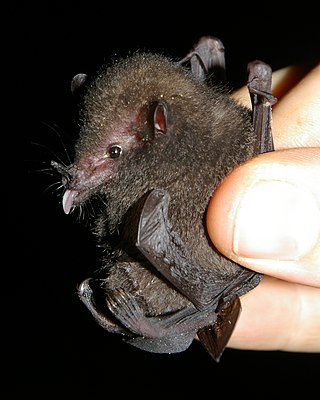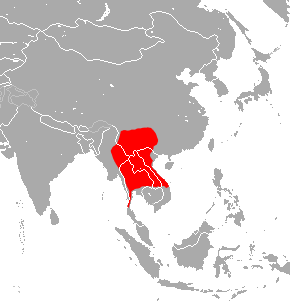
The New World leaf-nosed bats (Phyllostomidae) are found from southern North America to South America, specifically from the Southwest United States to northern Argentina. They are ecologically the most varied and diverse family within the order Chiroptera. Most species are insectivorous, but the phyllostomid bats include within their number true predatory species and frugivores. For example, the spectral bat, the largest bat in the Americas, eats vertebrate prey, including small, dove-sized birds. Members of this family have evolved to use food groups such as fruit, nectar, pollen, insects, frogs, other bats, and small vertebrates, and in the case of the vampire bats, even blood.

The dark long-tongued bat is a species of bat from South and Central America. It was formerly considered the only species within the genus Lichonycteris, but is now recognized as one of two species in that genus, along with the pale brown long-nosed bat. It is small species of bat, with adults weighing 6–11 g (0.21–0.39 oz) and having a total length of 46–63 mm (1.8–2.5 in).

Dekeyser's nectar bat is a bat species found in Brazil and Bolivia.

Lonchophylla is a genus of bats in the family Phyllostomidae.

The Mexican long-tongued bat is a species of bat in the family Phyllostomidae. It is the only species within the genus Choeronycteris. The species is found in El Salvador, Guatemala, Honduras, Mexico, and the United States.

Underwood's long-tongued bat is a species of bat in the family Phyllostomidae. It is the only species within the genus Hylonycteris. It is found in Belize, Guatemala, Mexico, Nicaragua, and Panama. Hylonycteris underwoodi feed on nectar, pollen grains, agave and fruits. This choice of food has allowed them to gain the ability of hovering flight, thereby evolving their body mass and size to compensate for the same.

The orange nectar bat is a species of bat in the family Phyllostomidae. It is found in Colombia, Costa Rica, Ecuador, Nicaragua, Panama, Peru, and Venezuela.

Thomas's horseshoe bat is a species of bat in the family Rhinolophidae. It is found in China, Laos, Myanmar, Thailand, and Vietnam.

Aratathomas's yellow-shouldered bat is a species of bat in the family Phyllostomidae native to South America.
The Thomas's yellow-shouldered bat is a species of bat in the family Phyllostomidae. It is endemic to Guadeloupe.

Marcgravia is a genus of plants in the Marcgraviaceae family commonly eaten by the dwarf little fruit bat. The genus is native to the Caribbean Islands, Central America, and South America, and genus is named in memory of the German naturalist Georg Marcgraf. The plant is visited by Thomas's nectar bat.

The cave nectar bat, dawn bat, common dawn bat, common nectar bat or lesser dawn bat is a species of megabat within the genus Eonycteris. The scientific name of the species was first published by Dobson in 1871.
Marcgravia evenia is a species of flowering vine in the family Marcgraviaceae. Within this family it belongs to the Galetae group, which is characterized by a long inflorescence axis and boat shaped nectaries. The plant is endemic to Cuba.
Hsunycteris is a genus of bats in the family Phyllostomidae and the only genus in the tribe Hsunycterini.

Lonchophyllinae is a subfamily of leaf-nosed bats.












